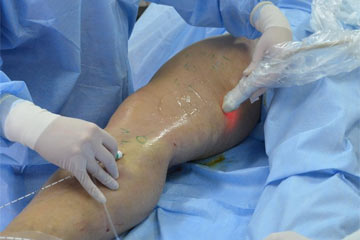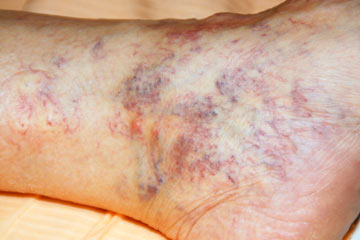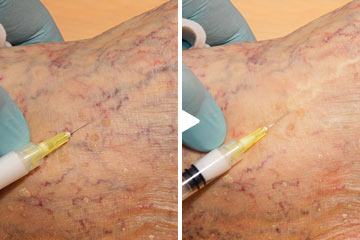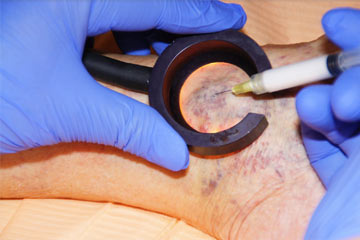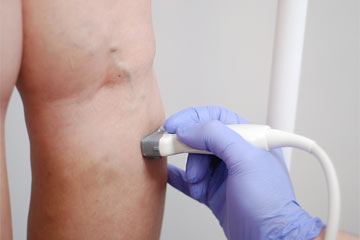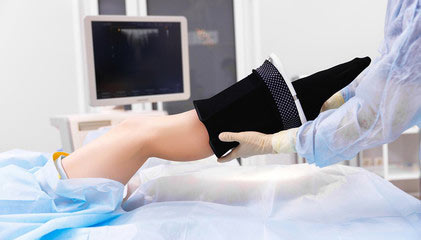Varicose Vein Removal
For those of you struggling with varicose veins, we have prepared a wealth of information about the causes of their formation as well as treatment methods. Thanks to our range of aesthetic medicine treatments, you can take action to combat this problem.
PHLEBOLOGY – Vein Surgery
Peripheral vascular diseases remain an important social issue. The significance of this problem is evidenced by the fact that every second person in industrialized countries suffers from atherosclerosis, arterial clots and embolisms, venous thrombosis, chronic venous insufficiency of the lower limbs, and varicose veins.
In Poland, as well as worldwide, it is estimated that about 20% of all diseases are vascular in origin, and vascular problems are more common than cancers. Both genetic factors (i.e., the disease being passed from generation to generation) and lifestyle conditions contribute to the prevalence of this issue. The increase in venous diseases is inextricably linked to the conditions of modern civilization.
Epidemiological studies show that in Poland, symptoms of venous insufficiency occur very frequently, affecting 47% of women and 37% of men, meaning that 42% of all Poles are affected. This is a tremendous social problem considering that 60% of this afflicted population is still not seeking treatment. Since ancient times, the most commonly treated venous diseases were VARICOSE VEINS and their complications. The oldest description of varicose veins of the lower limbs is found in ancient Egyptian papyrus.
Varicose Veins
Varicose veins are permanent, organic dilations of superficial veins, appearing as tortuous cords, meshes, or clumps, often with balloon-like protrusions. They are soft, painless, and the degree of their fullness depends on the position of the limbs. Varicose veins form due to an imbalance between the blood pressure in the vein and the strength of its wall. The most common factor causing increased pressure in the veins of the lower limbs is venous valve insufficiency. Varicose veins usually occur unilaterally and most often affect the great saphenous vein, the small saphenous vein, or both, including their main trunks and tributaries.
Types of changes:
- Superficial veins (telangiectasias and venulectasias, aka "spider veins")
- Deep veins
- Perforator and connecting veins
Dilated vessels, also known as venulectasias, are a sign that a patient has a vascular issue. They most commonly appear on the thighs, the knee area, the shins, and around the ankle. These vessels, which are either blue or red, look like a "fan." Nowadays, most problems related to venous diseases of the lower limbs are termed as – chronic venous insufficiency (CVI). Symptoms associated with venous insufficiency develop slowly but are not symptom-free, and they should not be trivialized, as untreated CVI often leads to leg ulcers.
Reflux, or the Backflow of Blood, as the Cause of Varicose Veins
In a standing position, venous blood in the legs flows from the feet upwards – towards the heart, thanks to:
- efficient venous valves,
- elastic venous walls,
- strong leg muscles.
When these mechanisms fail, blood flows backward. Doctors call this phenomenon reflux. The blood pressure in the veins increases. The venous vessels are connected, and the excess blood finds its way into other veins. Over time, "spider veins" or varicose veins develop.
Types of varicose veins:
- Primary varicose veins – occur with the normal condition of the deep venous system
- Secondary varicose veins – resulting from the failure of deep veins or arteriovenous fistulas
Taking into account predisposing factors, primary varicose veins occur with the normal condition of deep veins, and secondary ones are a complication of the failure of deep veins or penetrating arteriovenous fistulas.
Symptoms of this disease:
Women are affected 3-5 times more often than men. In the early stages, varicose veins do not cause any symptoms, and patients consult a doctor only for "cosmetic" reasons. Venous insufficiency often manifests itself with minor complaints. Therefore, people tend to ignore them, do not tell their doctor, or assume they are "normal" symptoms related to fatigue. The first symptom is usually a feeling of discomfort or heaviness in the limbs, occurring after prolonged standing. As the varicose veins enlarge and circulation disorders worsen, pain appears, described as dull or burning, intensifying after prolonged standing and in women before and during menstruation. Later, there are sensations of burning, throbbing, limb fatigue, as well as cramps in the feet and calves. There are also edemas, initially appearing in the evening, located on the feet and around the ankles. Later, the edema extends to the lower leg and does not go away even when resting. Varicose veins appearing during pregnancy cause more symptoms than those outside of pregnancy. In the pathogenesis of varicose veins in pregnant women, the increased volume of circulating blood and mechanical hindrance to blood outflow from the lower extremities play a certain role. The hereditary occurrence of varicose veins is proven, but the mode of inheritance has not yet been determined.
Symptoms of chronic venous insufficiency:
- calf cramps occurring after a full day's work and at night,
- a feeling of tension in the calves,
- calf muscle pain at rest, in the evening, after a full day,
- tingling, burning, and throbbing in the limbs,
- a feeling of heaviness in the legs,
- the sensation of "restless legs," meaning difficulty in finding a comfortable position after fatigue, feeling that changing the leg position will reduce discomfort,
- a feeling of "fullness" in the limb,
- brownish discoloration of the ankles,
- edema of the lower legs not going away after a night's rest,
- leg pain after prolonged standing (dull and burning),
- pain relief after elevating the legs.
Complications:
In many cases, varicose veins do not cause any complications. Sometimes, however, they can be the cause of inflammatory conditions – painless hardening and redness of the skin appear along their course. This leads to vein inflammation or closure of the vein by a blood clot (thrombosis). The detachment of such a clot and its movement along with the blood can cause very serious consequences. In chronic conditions, the skin color of the calves changes to brown due to abnormal blood circulation. Over time, itching, eruptions, and even cracks appear on the damaged skin covering the varicose veins – an open wound forms on the leg. For these reasons, varicose veins should be examined and appropriately treated as soon as possible.
When should you consult a doctor?
- If symptoms of venous insufficiency appear – leg pain, calf cramps, edema – early assessment of the venous system may prevent further disease progression
- If we find that "spider veins" or varicose veins have appeared on the leg, early diagnosis and treatment can halt further disease progression and avoid more invasive treatments in the future
- If we notice that the leg suddenly swells, turns a bluish-red color, and hurts, the reason for the symptoms could be a blood clot lodged deep in the vein – a venous system examination should be conducted as soon as possible
- If varicose veins are accompanied by pain, skin changes, or open wounds – proper diagnosis and appropriate treatment significantly shorten the time for recovery
- If varicose veins are cosmetically bothersome
Predispositions and Causes of Varicose Veins:
- Genetic factors
- Age
- Female gender
- Overweight and obesity
- Sedentary lifestyle
- Low physical activity
- Pregnancy
- Disorders in blood coagulation (lack of clotting proteins)
- Past hormonal therapy
- Hormonal contraception
- Deep vein inflammation
- Thrombosis
- Frequent hot baths
- Chronic sun exposure
- Overuse of saunas
- Underfloor heating
- Wearing high heels
- Remaining too long in a standing or sitting position
Stages of Chronic Venous Insufficiency (CVI):
- Invisible and unfelt changes (e.g., a feeling of heavy legs)
- Teleangiectasia and reticular veins
- Varicose veins
- Swelling
- Swelling without skin changes
- Trophic skin changes
- Skin changes with healed ulceration
- Trophic skin changes and active ulceration
How we diagnose and treat different stages of CVI:
1. Invisible and unfelt changes
How do we diagnose?
Based on subjective symptoms:
- Calf cramps occurring after a full day's work and at night
- Feeling of calf tightness
- Calf muscle pain at rest, in the evening, after a full day
- Feeling of "restless legs" (it's hard to find a comfortable position when tired, sensation that changing leg position will reduce discomfort)
- Minor swelling of the lower legs in the evening, not including the feet (this swelling goes away after a night's rest)
A family history is important: the occurrence of varicose veins in parents, grandparents, siblings, especially on the female side.
Treatment of varicose veins:
- elimination of risk factors
- compression therapy
- phlebotropic medications
2. Teleangiectasia and Reticular Veins
In addition to symptom-free stage signs, small dilated venous vessels with a small diameter appear in the skin.
Teleangiectasia (venulectasia)
- These are expansions of the subpapillary venous plexus in the proper skin
- They may appear singly or in clusters
- They resemble tree branches
Reticular veins
- Small diameter (2-4mm)
- Located in the subcutaneous tissue resembling a fishing net, usually around the popliteal fossa or on the lateral surfaces of the lower limbs
- Often similar to teleangiectasia, described as a "pine crown"
Treatment:
- obliteration, i.e., sclerotherapy of vessels
- compression therapy
- phlebotropic medications
3. Varicose Veins
Varicose veins usually occur unilaterally and affect the great saphenous vein (vena saphena magna – in about 30% of cases this vein has a double trunk), the small saphenous vein (vena saphena parva) or both at the same time, and this applies to both main trunks and their tributaries. Around their junction with the deep system, so-called ostial varicose veins may occur.
Other varicose veins:
- Concerning the connections of the tibial vein with the fibular vein
- Concerning additional venous trunks
- Caused by the insufficiency of perforating veins
- Secondary varicose veins
- "Varicose pearls"
- "Canyon" varicose veins
- Varicose veins in pregnant women
- Varicosity of the perineum
- Varicose veins of the persistent sciatic vein
It's important to remember that the cause of varicose veins is not only the insufficiency of the main venous trunks and their junctions to the deep system but also the insufficiency of the valves in the deep veins.
Treatment:
- Surgical treatment
- Obliteration
- Compression therapy
- Phlebotropic drugs
4. Edema without skin changes
Varicose veins are accompanied by mild or moderately severe edema, which may be unilateral or bilateral. A characteristic feature is their increase during the day and decrease, or even complete disappearance, at night. They diminish during exercise, compression therapy, and the use of phlebotropic drugs.
It's crucial to differentiate edema as many systemic and local pathologies can cause edema, such as:
- Lymphatic edema
- Fatty edema
- Edema in the course of deep vein thrombosis
- Recurrent premenstrual edema
- Cardiogenic edema
- Hormonal edema
- Edema due to renal insufficiency
Treatment:
- Phlebotropic drugs
5. Trophic skin changes
- Discolorations
- Eczema
- Lipodermatosclerosis
Progression of chronic venous insufficiency, in addition to the symptoms mentioned in the other 4 stages of the disease, leads to ischemic skin changes caused by blood stagnation, i.e., poorer blood supply. The skin becomes thin, and brown discolorations appear in the ankle area, along with eczema that may become infected; lipid and skin hardenings also appear.
Treatment:
- involves improving venous outflow, surgical treatment is applied
- Compression therapy
- Phlebotropic drugs
6. Skin changes with healed ulceration
The progression of skin ischemia from trophic skin changes can easily lead, even with minor trauma, to the formation of very difficult-to-heal ulcers in the ankle area. Due to impaired blood supply and infection of the ulcer, its healing poses a significant problem.
Treatment:
- In the treatment of skin changes and prevention of ulcer formation, a significant role is played by phlebotropic drugs, in addition to classic surgical treatment and SEPS (subfascial endoscopic perforator surgery)
7. Active trophic skin changes and ulceration
Active venous ulceration is associated with:
- Venous hypertension in the superficial and/or deep system
- Leads to skin ischemia, which with minor trauma can lead to skin necrosis and the formation of an active ulcer
- In about 10% of cases, the cause is only organic changes in the superficial venous system. This is a very common complication, affecting about 1% of the entire Polish population.
Treatment:
- the stagnation of blood should be reduced through drainage positioning
- use of compression therapy
- methods such as SEPS - the procedure can be performed with active ulceration
- use of phlebotropic drugs
Treatment of Chronic Venous Insufficiency
Untreated chronic venous insufficiency can lead to very dangerous, even life-threatening complications, such as thromboembolic disease, which in most cases is asymptomatic. The first symptom can be a pulmonary artery embolism, and if it is massive, it can be fatal. Another very troublesome complication is hard-to-heal trophic ulcers on the lower legs. This all means that you should not underestimate "seemingly insignificant" varicose veins. Chronic venous disease can be treated either surgically or conservatively. About 20% of patients qualify for surgical treatment. The remaining 80% require conservative treatment.
Treatment of Varicose Veins and CVI:
1. Compression Therapy
Compression therapy, or the use of special compression garments (stockings, socks, knee-highs), aims to slow down the development of varicose veins and to prevent the disease in predisposed individuals. Phlebotropic drugs must be combined with compression therapy for proper treatment outcomes.
2. Pharmacological Treatment
Conservative treatment won't remove varicose veins. Its aim is to alleviate symptoms and discomfort associated with varicose veins. The use of phlebotropic drugs and ointments alleviates symptoms of venous insufficiency. They reduce the feeling of heavy legs, cramps, and swelling. Medications containing diosmin or troxerutin enhance the elasticity and tension of the venous walls, aiding the return of blood from the veins to the heart. These drugs tighten the vessel walls, effectively reducing edema. The effectiveness of the drugs has been scientifically proven.
3. Sclerotherapy
This involves administering a special agent into diseased veins to destroy them, leading to their scarring and exclusion from the circulatory system. The medication is administered in liquid form or as a foam. Ultrasound is essential in sclerotherapy to identify diseased veins and monitor the drug administration process to ensure the sclerosing agent does not leak outside the vein. Leakage into the subcutaneous tissue can cause skin necrosis.
4. Surgical Treatment
Involves the surgical removal of diseased veins, the main trunk of the so-called saphenous vein, and visibly expanded varicose veins. Anesthesia is required.
5. Laser Removal of Varicose Veins:
- endovenous laser
Endovenous Laser Treatment (EVLT) is a method of treating venous insufficiency by irradiating the incompetent vein trunk using a laser fiber inserted into it. The released energy causes the vein to shrink and close, eliminating the need for its removal. This method avoids an incision in the groin and postoperative hematoma associated with conventional procedures.
- NdYag laser
- IPL laser
WAYS TO PREVENT AND ALLEVIATE SYMPTOMS OF VENOUS INSUFFICIENCY:
1. Physical Activity:
- Lose excess weight
- Avoid prolonged standing and sitting
- Engage in sports (swimming, cycling, dancing, jogging, golf, walking, water walking, and cross-country skiing have a beneficial effect on veins)
- Avoid sports that increase the strain on the venous system of the lower extremities or involve sudden changes in blood flow (e.g., weightlifting, tennis, soccer, skiing, martial arts)
- Use compression therapy during physical activity
2. Clothing
Any clothing that constricts your body around the legs, hips, and waist is an additional obstacle to venous return. Ordinary knee-highs exert the most pressure just below the knee, so you should remove them from your wardrobe. Shaping tights too tightly constrict the hips and waist. Similarly, stockings and belts are harmful. You should prefer sporty clothing that does not restrict your muscles and does not tighten veins.
3. Footwear
Avoid improper footwear
- High heels make you walk on your toes constantly and block muscles
- Flat shoes exert continuous strong pressure on the heels
4. Temperature
- Avoid high ambient temperatures: hot baths, saunas, prolonged sunbathing, hot wax hair removal, underfloor heating
- Take cold showers – cold water stimulates the tension of the venous walls and improves blood flow through the veins. Cold constricts veins, and gentle water massage in the direction of blood flow is highly recommended.
5. Medication
Scientific studies have shown the significant role of female sex hormones in the development of venous insufficiency. The use of hormonal agents has become widespread, for example in contraception, acne treatment, or relieving the effects of menopause. If you suffer from venous insufficiency or observe this condition in your family, you should consult a specialist before using such treatment. If you are already using such drugs, monitor the condition of your veins, and if symptoms of venous insufficiency worsen, report it to the doctor.
6. Rest
- Rest with your legs elevated for at least 10 minutes a day (lie on the floor and rest your feet against the wall or the edge of a chair – this facilitates venous return)
- Elevate the legs of the bed by 10-20cm or use special wedges so that the angle of inclination to the ground is approximately 10 degrees – this improves venous return and helps in absorbing edema; NOTE! Do not just elevate the limbs – this leads to overgrowth and later degeneration of the knee joints.
TELANGIECTASIA or "SPIDER VEINS"
“Spider veins” or telangiectasia are the first sign that something bad is starting to happen with our veins. As soon as they appear, medical advice should be sought, as smaller "varicose veins" can develop into more dangerous varicose veins in the future.
Telangiectasias appear as enlarged and elongated small venous plexuses located intradermally and subdermally with a diameter of about 0.1-1mm. They can be red or blue in color. The typical area of their occurrence is the lateral surface of the thigh, the medial surface of the knee, and the area of the popliteal fossa. They often take the shape of a radial structure resembling a tree branch or have an undefined shape. The color of telangiectasia depends on the diameter of the enlarged vein: - larger enlargements (not exceeding a diameter of 1mm) are dark blue in color. They are often palpable, as the enlarged veins raise the epidermis. The most superficially located and thinnest changes form a very delicate, scarlet network. These changes are often the first visible symptom of insufficiency of the peroneal vein or the deep vein system. In addition, pain and swelling accompanying “spider veins” significantly worsen the quality of life of patients.
Types of telangiectasia:
- Linear – not forming connections between them and usually located on the medial surface of the thigh, above the knee joint,
- Arborescent – usually located on the lateral surface of the thigh,
- Spider-like (radial) – radiating sideways from the central widest vessel,
- Nodular – unevenly scattered point enlargements of the vessels
Predispositions and causes of telangiectasia:
- Chronic exposure to the sun
- Too frequent use of tanning beds
- Large temperature fluctuations and high humidity
- Prolonged use of topical steroids, especially on the face, neck, and décolleté, in predisposed people (thin skin, light complexion, in children)
Methods of treating telangiectasia:
- Pharmacological treatment
- Obstructive treatment
- Laser treatment
The procedure of laser removal of "spider veins" involves directing a concentrated beam of laser light onto the vessel located under the skin. The laser light passes through the skin, sealing the damaged blood vessel. Before the procedure, the efficiency of the valves at the entrances of the peroneal veins is assessed using a Doppler Ultrasound examination.
Skin care for dilated capillaries:
- Skin renewal before UV (sun, tanning bed), use of preparations with UVB and UVA filters, as well as filters protecting against infrared
- Protecting the skin from cold and moisture – use protective creams during the fall-winter period
- Avoid overheating the facial skin in the sauna, hot air
- Supplementing vitamin deficiencies, mainly B2, Pp, C
- Use appropriate cosmetics for vascular skin, which help constrict blood vessels
Our procedure related to the treatment of varicose veins:



